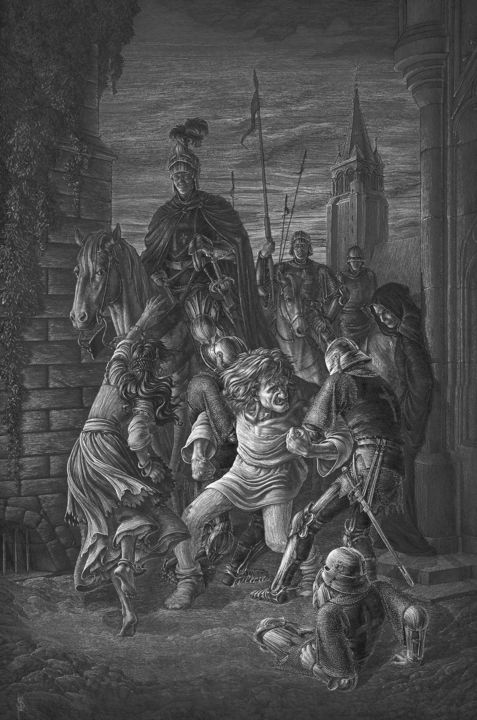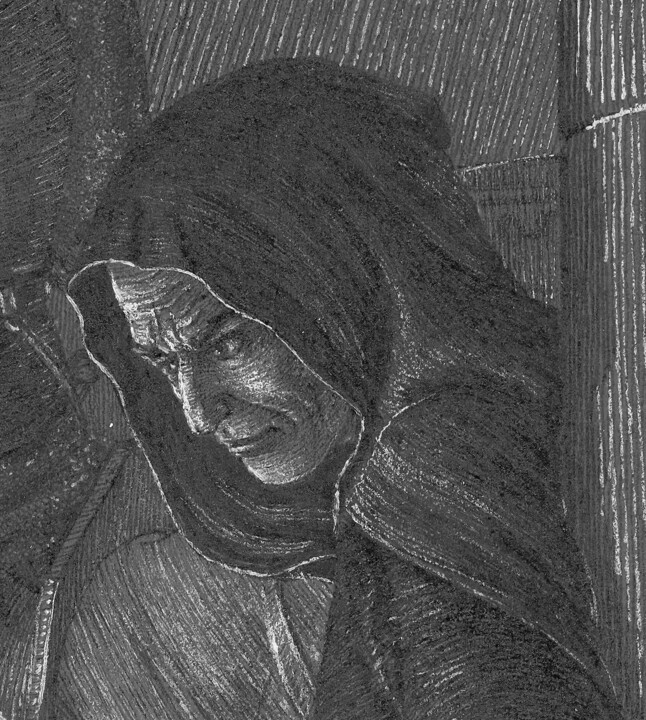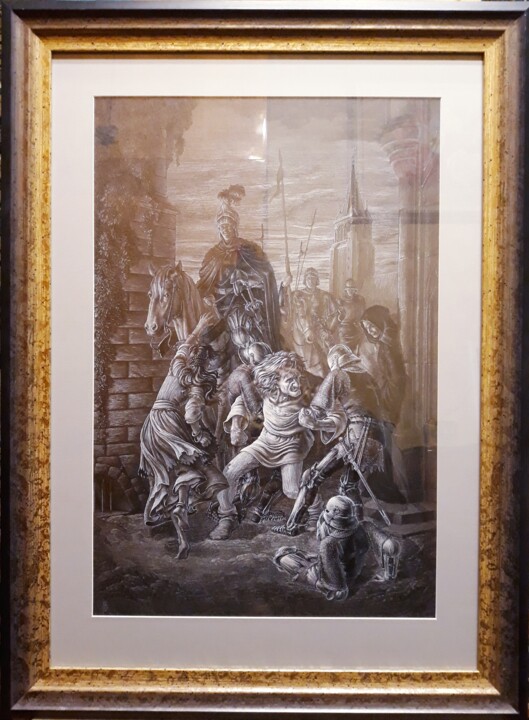





¡Háganos saber si le gustaría ver más fotos de esta obra de arte!
- Detrás del trabajo / lado del trabajo
- Detalles / Firma / Superficie o textura de la obra de arte
- Obra de arte en situación, Otro...
Arrest of Quasimodo. Original drawing by Irina Sumanenkova (2010) Dibujo por Irina Sumanenkova
Más información
- embalaje (Embalaje de caja o cartón) Todas las obras se envían cuidadosamente protegidas y aseguradas, con un transportista premium.
- Seguimiento Seguimiento del pedido hasta la entrega al comprador. Se proporcionará un número de seguimiento para que pueda seguir el paquete en tiempo real.
- Plazos de tiempo La mayoría de los paquetes se entregan en todo el mundo en un plazo de 1 a 3 semanas. (Estimar)
- Impuesto de aduana no incluido El precio no incluye gastos de aduana. La mayoría de los países no tienen impuestos de importación para obras de arte originales, pero es posible que deba pagar el IVA reducido. La oficina de aduanas calculará las tasas de aduana (si las hubiere) a la llegada y el transportista las facturará por separado.
Más información
- Certificado de autenticidad online rastreable Los certificados de autenticidad se pueden verificar en línea en cualquier momento escaneando el código de la obra de arte.
- Certificación de la cotización de artista. Los expertos estudian el conjuto de la obra de un artista y su carrera y luego establecen una cotización media independiente y fiable. La cotización media permite situar al artista en una gama de precios durante un período determinado. También se puede solicitar a los expertos que fijen una cotizacion para una obra en particular.
Más información
Pago seguro 100% con certificado SSL + 3D Secure.
Más información
Impresiones "Fine-Arts" en papel
Es un proceso de impresión en papel de arte usando tintas pigmentadas de muy alta calidad e impreso en muy alta definición. Su nivel de conservación es excepcional (más de 100 años), su calidad, profundidad y riqueza de matices supera la clásica impresión fotográfica en papel argentino.

Acabado brillante
Además de su grosor excepcional, el papel de fibra está compuesto de una base de alfa-celulosa sin ácido y está cubierto con sulfato de bario y una capa microporosa que mejora la absorción de pigmentos durante la impresión. Con un color blanco puro, no amarillento a claro, este papel está especialmente diseñado para resistir y envejecer. Es utilizado por los principales museos de todo el mundo, ya que ofrece una resolución excelente, y ofrece colores profundos y densos.
Obra de arte "Fine Art" - Acabado brillante sobre papel base de fibra 325 g.

Nuestras impresiones y reproducciones de gama alta
ArtMajeur solo utiliza papeles naturales con pH neutro, resistentes y de alta calidad, seleccionados de fabricantes de papel de renombre
Nuestra impresora maestra presta atención constante, ya sea en términos de control de color o respeto por la cadena gráfica. Nuestro alto nivel de exigencia de calidad es un activo importante de las impresiones artísticas enmarcadas de ArtMajeur.
Para los artistas! Usted ayuda a los artistas a vivir de su trabajo. Reciben el pago de sus derechos cada vez que usted compra sus impresiones.
Acerca de nuestras impresionesCompre una licencia para utilizar esta imagen en su sitio web, su comunicación o para vender productos derivados.
Usage: Licencia web
| 992 px | ||

|
1500 px |
| Dimensiones del archivo (px) | 992x1500 |
| Uso en todo el mundo | Sí |
| Uso en multi-soporte | Sí |
| Uso en cualquier tipo de medio | Sí |
| Derecho de revender | No |
| Número máximo de impresiones | 0 (Zero) |
| Productos destinados a la venta | No |
Descargar inmediatamente después de la compra
Esta imagen está disponible para descargar con una licencia: puedes descargarlos en cualquier momento.
Restricciones
Todas las imágenes de ArtMajeur son obras de arte originales creadas por artistas, todos los derechos están estrictamente reservados. La adquisición de una licencia da derecho a usar o explotar la imagen bajo los términos de la licencia. Es posible realizar modificaciones menores tales como reenfocar o reenfocar la imagen para que se ajuste perfectamente a un proyecto, sin embargo, está prohibido realizar cualquier modificación que pudiera dañar la obra original. En su integridad (modificación de formas, Distorsiones, corte, cambio de colores, adición de elementos, etc ...), a menos que se obtenga previamente una autorización por escrito del artista.
Licencias personalizadas
Si su uso no está cubierto por nuestras licencias estándar, póngase en contacto con nosotros para obtener una licencia personalizada.
Banco de imágenes de arte-
Obra de arte original (One Of A Kind)
Dibujo,
Tinta
/
Rotulador
en Papel
-
Dimensiones
28,4x20,9 in
Dimensiones del trabajo solo, sin marco: Altura 20,9in, Anchura 14in - Enmarcado Esta obra se enmarca (Marco + debajo del vidrio)
- Categorías Dibujos menos de 5.000 US$ Ilustración Arquitectura
Media: sketch marker to hatch all shadows and steel calligraphic pen and white ink to depict the light spots on a tinted paper.
Dimensions: 53 x 35.5 cm.
Dimensions in a frame+mat+glass: 72 x 53 cm.
My favorite technique for black and white works is a sketch marker, I use 0.05 mm and 0.1 mm in diameter only. This marker draws by pigment ink with alcohol, that`s why it dries almost immediatly.
About working process:
After the idea came, I begin to collect the information, depending on an era and country I need to depict. That means not only architecture, costumes and armor of that chosen time, but also faces for my characters. Because the type of French knight face of XV st. differ from the English one, German or Flanders of the same era. I search for the faces types in manusripts XV st., miniatures and paintings come down to us. Then I chose elements for a composition and drawing construction stage begins on paper. My academy drawing education helps me to create human figures for my ideas. Anatomy academic drawing I have learned in University from a Gottfried Bammes anatomy book. In order to portray a facial expression or a movement in a most natural way, I use photographs sometimes, but oftenly it comes from the imagination. I can draw a figure or head in any angle need. When the figures drawing is finished, I add clothes on them, every fold should be on it`s right place and characterize the type of textile. Historical costumes and armor depended on the era and country (in this case, 1482, France) and on the estate each character belongs to.
When the figures drawing is complete, I continue work with surroundings. The photogragh of architecture oftenly distorts the perspective and verticals. So, for my work, every building needs to be recreated anew, based on the photograph.
Next stage is shadow casting, depending on the light source from a photograph. It should help me to highlight my main characters. Sometimes shadows can create an unexpected effect need. The finished construction drawing now is ready to be carried on a tinted paper to hachure my drawing with marker and ink.
The hatching process is the most laborious, because my finished work looks like lithography, only it was made by hand directly on paper. Moving the line along, I have to keep in mind what I am hatching now: a face, a hand, a hair, an architecture, a type of textile (light or heavy fabric), is it a clothes on a figure or just a drapery, a metal armor, a ground, a stone or a sky - in order to depict any surface most naturally. That`s why I save the construction lines of all the objects after carring the drawing on a tinted paper to hatch. After the personages are finished, I can go on with surroundings, following up that every single line helps me to highlight the main characters and sculpt the another surface at the same time. That`s why the sky came in the last turn - it`s role not to interfere in composition most of the time, it`s just express the mood.
The light spots were hatched by calligraphic pen and white ink. The difficulty is that ink is in a little mason jar and every second it can be overturned unintentionally. And in the hatching process I have to dip the pen into ink every few seconds, because it can`t keep very much quantity of ink for longer working time - it`s too small. If the pen will be bigger, then it`s diameter will be bigger, and I wouldn`t be able to hatch a touchiness.
That`s why 3 square centimeters take 2 hours.
The main difference between this technique and oil painting is that here I don`t have much opportunity to correct, if something went wrong. Everything should be executed from the first time. It can be only lighten or darken a little in a small spots, that`s all. This is the last stage - to conform the whole work, to harmonize everything in it.
About idea:
This artwork is based on the novel “Notre-Dame-de-Paris” by Victor Hugo. The ivy is the symbol of the death, (the ancient Greeks have planted it on graves) is pointing to the grate near the ground, but, maybe, it’s the grating of a prison, which later they will get into. The tower of Saint-Germain-de-Pres on background – is the symbol of the spiritual perfection and, at the same time, of the loneliness, because a man, who live in a tower, is between heaven and ground, - he is already not belong to those, living on earth, but not reach the heaven wisdom yet. The night watch how the masters of life surround them, they are stymied, and there is no way out for them – all what should to be happen, came already.
Everything is against them – people, earth and architecture, they are the outcasts of the nature and society, and only the sky empathize with them.
The church Saint-Germain-de-Pres attests to the particular scene of action, Paris, and as the writer describes this scene far away from the centre of the city, and I can’t, even for the symbolism, depict Notre-Dame-de-Paris on background.
Share the image of original drawing ,, Arrest of Quasimodo,, by Irina Sumanenkova in your social media and buy the original!
Temas relacionados
Irina SumanenkovaVictor HugoNotre-Dame-De-ParisNovelIllustration
Irina Sumanenkova es una artista ucraniana contemporánea de Kiev. Apasionada por el arte desde pequeña, cree que todo el mundo tiene un lado creativo innato, muchas veces expresado a través de actos tan simples como coger un lápiz o un rotulador. Irina decidió seguir este camino creativo, dedicándose a desarrollar un estilo único que combina realismo, simbolismo, neoimpresionismo y elementos de ambos. Su obra de arte abarca una amplia gama de temas, incluidas piezas conceptuales, vida silvestre y fantasía. Sus géneros favoritos incluyen retratos, paisajes (particularmente montañas), temas animales, florística e ilustración.
Irina tiene una Maestría en Bellas Artes y estudió pintura en la Universidad Nacional de Construcción y Arquitectura de Kiev. Inicialmente se consideraba una artista gráfica, centrándose en la pluma y la tinta sobre papel, pero sus estudios de pintura influyeron profundamente en su visión artística y se convirtieron en parte integral de su vida. Desde que se graduó, ha ilustrado varios libros y continúa pintando. Irina también es miembro de la Academia Internacional de Arte Contemporáneo - Artlookone.
-
Nacionalidad:
UCRANIA

- Fecha de nacimiento : 1982
- Dominios artísticos: Obras de artistas con valor de artista certificado,
- Grupos: Artistas certificados Artistas Contemporáneos Ucranianos













